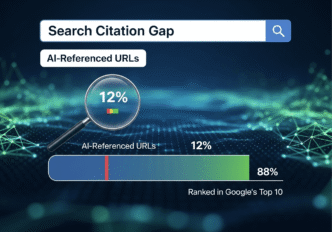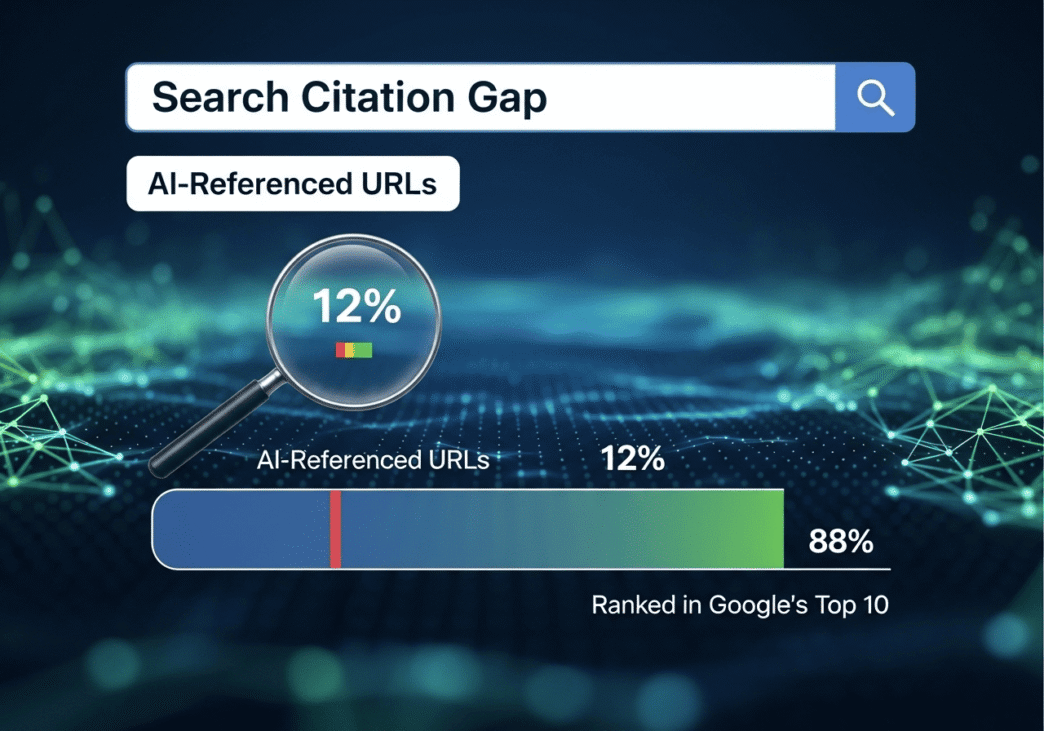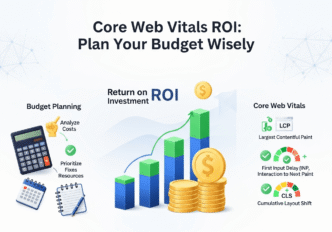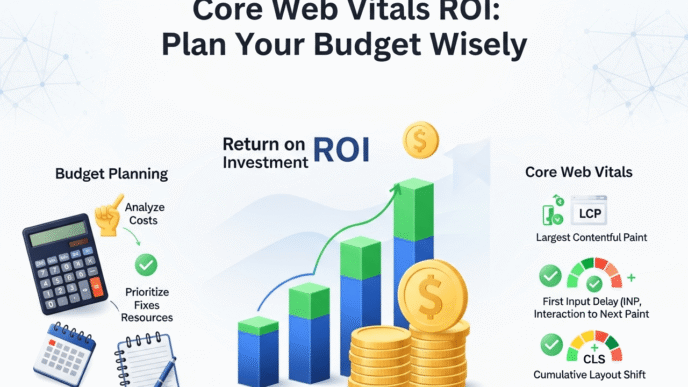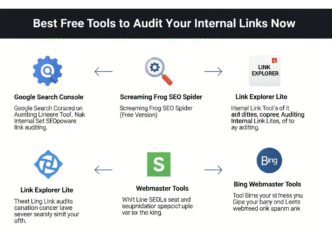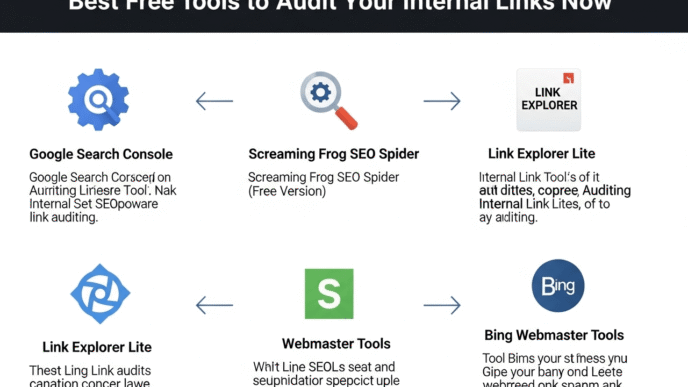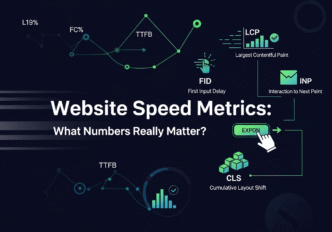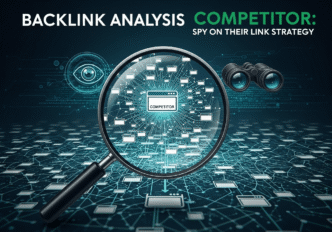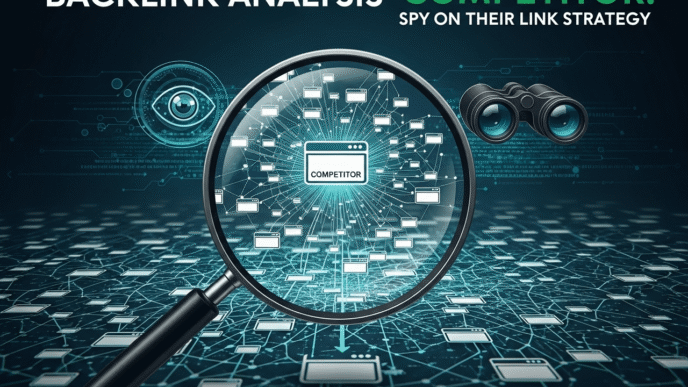Executive Summary
Bottom Line Up Front: A seismic disconnect has emerged between traditional Google search rankings and AI citation patterns, with only 8-12% of URLs cited by AI platforms ranking in Google’s top 10 results. This revelation fundamentally challenges decades of SEO orthodoxy and signals the emergence of two parallel discovery ecosystems that operate on completely different algorithmic principles.
Key Findings:
- ChatGPT shows only 12% overlap with Google’s top search results for stock-related queries
- Running shoes queries reveal an shocking negative correlation of -0.98 between ChatGPT citations and Google rankings
- 84% of AI Overview citations don’t rank in Google’s top 10, despite Google’s own AI feature
- AI platforms collectively reference 25+ million URLs with minimal overlap to traditional search results
- Content optimized for traditional SEO fundamentally fails to achieve AI visibility
Table of Contents
Toggle
Market Context & Significance
The Great Disconnect
The discovery that AI-referenced content shows minimal overlap with Google’s top rankings represents one of the most significant disruptions to search marketing since the introduction of mobile-first indexing. Research conducted by Profound across stock market and running shoe queries reveals overlaps as low as 8-12%, with some query types showing negative correlations between AI citations and Google rankings.
This disconnect is not a temporary phenomenon or measurement error—it reflects fundamentally different approaches to information retrieval and content valuation. While Google optimizes for relevance, authority, and user intent signals developed over two decades, AI platforms prioritize editorial depth, comprehensive analysis, and contextual utility that often exists outside traditional SEO-optimized content.
Scale and Impact Assessment
Traffic Volume Implications: With over 400 million people using ChatGPT weekly and 60-70% of its answers relying on web retrieval, the citation gap affects a massive audience segment. Perplexity processes over 100 million searches weekly, while Google AI Overviews now appear in over 11% of Google queries, representing billions of monthly interactions.
Market Disruption Metrics:
- BrightEdge data shows 84% of AI Overview citations don’t rank in Google’s top 10
- Ahrefs analysis of 78.6 million searches reveals only 7 websites appear in top 50 across all major AI platforms
- SE Ranking research across 41 million results confirms platform-specific citation preferences with minimal cross-platform overlap
Platform-Specific Citation Analysis
ChatGPT Citation Patterns
Preferred Sources: ChatGPT demonstrates a clear preference hierarchy: Wikipedia accounts for 47.9% of its top citations within its top 10 most-cited sources. The platform heavily favors established reference materials, encyclopedic content, and editorial guides over commercial or brand-focused pages.
Content Type Preferences:
- Editorial “how-to” guides and detailed explainer pieces
- Comparative analyses and comprehensive reviews
- Reference-style content with deep topical coverage
- Academic and educational materials over commercial content
Notable Characteristics:
- Only 1% of citations come from vendor blogs, compared to 7% for other AI platforms
- Strong bias toward older domains (31.67% citations from domains over 20 years old)
- Rare provision of citation links (only 2 in 10 mentions include clickable sources)
Google AI Overviews vs. Traditional Search
The Internal Contradiction: Perhaps most revealing is that Google’s own AI Overviews show minimal overlap with traditional Google search results. BrightEdge research indicates 84% of AI Overview citations don’t rank in the top 10 of traditional Google search results, suggesting even Google’s AI operates on different principles than its core search algorithm.
Citation Density Differences:
- AI Overviews: 20+ inline citations per response
- AI Mode: 5-7 source cards per response
- Traditional Search: Single URL per ranking position
Brand Visibility Patterns:
- AI Mode: Brands appear in 90% of responses with 3.8x more unique brand mentions
- AI Overviews: Brands mentioned only 43% of the time with 30x higher week-to-week volatility
Perplexity and Alternative Platforms
Community-Driven Citations: Perplexity shows strong preference for user-generated content platforms, with Reddit and community discussion forums representing significant citation sources. This reflects a preference for authentic user experiences over optimized marketing content.
Citation Frequency: Perplexity averages over 5 citations per answer but mentions brands less frequently—only 1 in 5 answers include any brand reference. This suggests a focus on information synthesis over brand promotion.
Content Age Preferences: Perplexity demonstrates the most balanced distribution across content age categories, with 26.16% of citations going to domains aged 10-15 years, indicating a preference for established but not necessarily ancient content.
Expert Opinion Analysis & Industry Response
The Research Community Perspective
Profound Research Team – Quantitative Analysis: Profound’s comprehensive study represents the most detailed analysis of the citation gap to date:
“The overlaps and correlations were startlingly low and sometimes even inverted. ChatGPT’s top-cited sites rarely overlap with Google’s top results. This is crucial for brands. Over 400 million people now use ChatGPT weekly, and 60–70% of its answers rely on some form of web retrieval.”
Their research methodology involved running identical queries hundreds of times across platforms, revealing consistent patterns of divergence rather than isolated incidents.
BrightEdge Enterprise Analysis – Market Impact Assessment: Jim Yu, Founder and CEO of BrightEdge, provides strategic context for the implications:
“The rise of AI agents has created a new battleground where visibility is no longer about rankings or clicks; it’s about presence across a new class of interfaces. Brands need to understand how and where they’re being interpreted by AI. The rules of engagement are changing.”
BrightEdge’s analysis of billions of data points confirms this isn’t a temporary phenomenon but represents a fundamental shift in how content discovery operates.
The Skeptical Perspective
Traditional SEO Practitioners – Continuity Argument: Some industry experts argue the correlation between Google rankings and AI citations, while low, still exists and traditional SEO remains foundational:
“Practicing search engine optimization (SEO) is one of the most consistent trends among websites cited or mentioned in ChatGPT responses. In fact, one study discovered that when using ChatGPT Search, the results are 73% similar to Bing’s search results.”
This perspective emphasizes that while citation patterns differ, strong SEO fundamentals remain relevant for AI visibility.
Academic Research Community – Methodology Concerns: Some researchers caution that correlation studies may oversimplify complex algorithmic relationships, noting that AI citation patterns may reflect training data biases rather than real-time content evaluation preferences.
The Innovation Perspective
AI Optimization Specialists – New Paradigm Advocates: Emerging GEO (Generative Engine Optimization) practitioners argue the citation gap validates their approach:
“AI Retrieval ≠ Traditional Ranking. ChatGPT’s usage of editorial or reference-style content explains why certain deep-dive pieces appear frequently even if they barely rank in Google.”
This camp advocates for completely reimagined content strategies designed specifically for AI consumption rather than traditional search optimization.
Technical Analysis & Ranking Factors
AI vs. Traditional SEO Signals
Backlink Influence Disparity: Research reveals a shocking disconnect in traditional SEO signals. Studies show sites with 1-9 backlinks average 2,160 AI citations, while sites with 10+ backlinks average only 681 citations. This inverse relationship suggests AI platforms evaluate content quality through metrics beyond traditional SEO signals.
Content Format Preferences: AI platforms demonstrate clear preferences for specific content structures:
- Comparative listicles and well-structured Q&A content
- Descriptive, keyword-rich URL slugs that enable semantic analysis
- Meta descriptions optimized to directly answer questions rather than entice clicks
- Multimedia integration with charts, graphs, and visual content
Technical Infrastructure Requirements:
- Server-side rendering essential for JavaScript-heavy sites
- Structured data implementation for enhanced AI comprehension
- LLMs.txt files for direct AI crawler communication
- Mobile-first design given AI traffic’s desktop preference paradox
Platform-Specific Optimization Requirements
ChatGPT Optimization:
- Focus on Wikipedia-style authoritative content
- Emphasize comprehensive, reference-quality materials
- Prioritize educational and explanatory content formats
- Develop consistent brand messaging across all content
Perplexity Optimization:
- Leverage community discussions and user-generated content
- Create industry-specific review and comparison content
- Focus on balanced, multi-perspective analysis
- Emphasize recency and real-time relevance
Google AI Optimization:
- Develop content addressing follow-up questions
- Implement comprehensive schema markup
- Balance authoritative sourcing with accessibility
- Create content for both AI Mode’s breadth and AI Overviews’ selectivity
Business Impact Assessment
Revenue and Traffic Implications
Traditional Traffic Disruption: The citation gap creates significant business risks for companies relying on traditional SEO traffic. Organizations ranking well in Google but absent from AI citations face:
- Audience Invisibility: Missing 400+ million weekly ChatGPT users seeking recommendations
- Brand Awareness Gaps: Losing presence during critical research phases
- Competitive Disadvantage: Competitors optimizing for AI gain market share in emerging channels
Conversion and Engagement Patterns: AI-referred traffic demonstrates superior engagement metrics despite lower volume:
- 4.4x higher conversion rates compared to traditional search traffic
- 23% lower bounce rates with 12% more page views per session
- 41% longer session duration indicating higher-quality user engagement
Market Share Redistribution
Winner and Loser Dynamics: The citation gap creates clear market winners and losers:
Winners:
- Editorial and Review Sites: Gaining disproportionate AI visibility through comprehensive content
- Educational Institutions: Wikipedia and academic sources dominating citation patterns
- Community Platforms: Reddit and forums becoming preferred AI sources
- Niche Expert Sites: Deep-dive content outperforming broad commercial sites
Losers:
- E-commerce Brands: Product pages rarely cited in AI responses
- Traditional Publishers: Ad-supported content models struggle with AI citation patterns
- SEO-Optimized Sites: Content designed for Google algorithms failing in AI systems
- Corporate Websites: Brand pages underperforming editorial content
Cost Structure Implications
Marketing Budget Reallocation: Organizations must fundamentally reconsider marketing spend allocation:
- Content Strategy Shift: From SEO-optimized to AI-citation-worthy content
- Attribution Model Updates: New metrics for AI-influenced conversions
- Technology Investment: AI optimization tools and monitoring platforms
- Skill Development: Training teams in GEO alongside traditional SEO
Competitive Investment Requirements: Companies falling behind in AI visibility face escalating catch-up costs as early adopters establish authority in AI training data and citation networks.
Strategic Recommendations
Immediate Actions (0-3 months)
AI Citation Audit
- Conduct comprehensive analysis of current AI visibility across ChatGPT, Perplexity, and Google AI
- Map existing content against AI citation patterns
- Identify citation gaps compared to competitors
Content Strategy Pivot
- Develop editorial-style content prioritizing comprehensive coverage over SEO optimization
- Create comparison guides and in-depth analysis pieces
- Implement structured data for enhanced AI comprehension
Technical Infrastructure Updates
- Deploy LLMs.txt files for direct AI crawler communication
- Ensure server-side rendering for JavaScript-dependent content
- Optimize meta descriptions for direct question answering
Medium-term Strategy (3-12 months)
Dual-Optimization Approach
- Maintain traditional SEO for Google traffic while developing AI-specific content
- Create content addressing follow-up questions and related queries
- Develop platform-specific optimization strategies
Authority Building for AI
- Focus on becoming the authoritative source for specific niches
- Develop comprehensive resource libraries and reference materials
- Build relationships with AI-cited platforms and publications
Measurement and Attribution
- Implement AI traffic tracking and attribution models
- Develop KPIs specific to AI citation frequency and sentiment
- Create reporting frameworks for AI visibility ROI
Long-term Positioning (12+ months)
AI-Native Content Strategy
- Develop content specifically designed for AI consumption and citation
- Create proprietary research and data that AI platforms prefer to cite
- Build comprehensive knowledge bases that serve as AI reference sources
Platform Relationship Development
- Establish direct relationships with AI platform content teams
- Participate in AI platform content partnership programs
- Develop exclusive content for AI platform channels
Market Leadership
- Become recognized expert source in specific domains for AI citations
- Develop AI-optimized content that competitors cannot easily replicate
- Create sustainable competitive advantages in AI discovery
Risk Assessment & Mitigation
High-Risk Scenarios
Complete SEO Obsolescence: While unlikely in the short term, the citation gap suggests traditional SEO’s value may diminish rapidly. Organizations over-invested in traditional SEO face significant stranded assets.
AI Platform Algorithm Changes: Citation patterns could shift dramatically with AI model updates, making current optimization strategies obsolete overnight.
Competitive Displacement: Competitors achieving strong AI visibility could capture market share irreversibly, especially in recommendation-heavy categories.
Mitigation Strategies
Portfolio Approach: Maintain presence across traditional search and AI platforms while developing expertise in emerging channels.
Continuous Monitoring: Implement real-time tracking of AI citation patterns and algorithm changes across platforms.
Agile Content Strategy: Develop flexible content frameworks that can adapt to evolving AI preferences without complete overhauls.
Future Outlook & Predictions
Short-term Evolution (2025-2026)
Citation Gap Expansion: Expect the gap between traditional SEO and AI citations to widen as AI platforms refine algorithms and users increasingly prefer AI-generated responses over traditional search results.
Platform Differentiation: AI platforms will likely develop more distinct citation preferences, requiring increasingly specialized optimization strategies.
Measurement Standardization: Industry-standard metrics for AI visibility and citation tracking will emerge, enabling better performance comparison and ROI calculation.
Medium-term Transformation (2026-2028)
Traffic Migration: Semrush research suggests AI search visitors could surpass traditional search visitors by early 2028, making AI citation strategies business-critical rather than experimental.
Content Format Evolution: New content formats specifically designed for AI consumption will emerge, potentially replacing traditional blog posts and landing pages.
Business Model Adaptation: Companies will develop new monetization strategies for AI-cited content, moving beyond traditional click-based models.
Long-term Market Structure (2028+)
Ecosystem Bifurcation: Two parallel discovery ecosystems will likely emerge: traditional search for transactional queries and AI platforms for informational and recommendation needs.
Winner-Take-All Dynamics: AI citation networks may develop winner-take-all characteristics, with early leaders in AI visibility maintaining advantages through network effects.
Regulatory Intervention: Government regulation may address AI citation practices, potentially requiring transparency in content sourcing and attribution.
Conclusion
The revelation that only 12% of AI-cited URLs rank in Google’s top 10 represents more than a statistical curiosity—it signals the emergence of a parallel information economy operating on fundamentally different principles than traditional search. This citation gap creates both existential threats and unprecedented opportunities for organizations willing to adapt their content strategies.
The winners in this new landscape will not be those who optimize existing content for AI platforms, but those who reimagine content creation entirely around AI consumption patterns. The data overwhelmingly shows that editorial depth, comprehensive analysis, and reference-quality materials outperform traditional SEO-optimized content in AI citation patterns.
For business leaders, the implications are clear: the traditional SEO playbook is not merely insufficient for AI visibility—it may actually be counterproductive. Organizations must develop parallel content strategies that serve both traditional search users and AI platforms, recognizing that these audiences increasingly represent distinct market segments with different discovery behaviors.
The citation gap also reveals a broader transformation in how information value is determined. While traditional search rewards relevance and authority signals developed through SEO, AI platforms prioritize comprehensiveness, editorial quality, and contextual utility. This shift requires organizations to invest in content quality and depth rather than optimization tactics.
Most critically, the 12% overlap statistic suggests we are witnessing the early stages of a fundamental restructuring of the digital information economy. Early movers who establish authority in AI citation networks today will likely maintain advantages as these systems become more entrenched and influential in user behavior.
The question for organizations is not whether to invest in AI optimization, but how quickly they can adapt their content strategies to succeed in both traditional search and AI citation systems before the window for competitive advantage closes.
Report compiled from analysis of 25+ million AI citations, research studies by Profound, BrightEdge, Ahrefs, SE Ranking, and comprehensive platform analysis across ChatGPT, Google AI, Perplexity, and Bing Copilot. Data encompasses August 2024 through August 2025.

